When cruisers go ashore at Rhodes, Greece, they may envision themselves as "time travelers." It's certainly easy to do that while exploring sites dating from ancient Dorian, Greek, Roman and Byzantine times, or in gazing at the aqua-blue bay near Lindos where St. Paul, the Apostle, came ashore in the first century A.D. to preach Christianity on the island.
It also seems natural to "slip into the past" while strolling through Rhodes' Old City, often described as modern Europe's best preserved Medieval center. Today, it's a UNESCO World Heritage Site. Here, the Order of the Knights of St. John of Jerusalem (later renamed the Order of the Knights of Rhodes) ruled for two centuries during the Crusades, religious wars with Muslims in the Holy Land. The knights tapped Rhodes as their fortified eastern Mediterranean naval base.
In July 2021, Travel Agent journeyed ashore at Rhodes during Celestyal Cruises' seven-night “Idyllic Aegean” voyage roundtrip from Athens on Celestyal Crystal.
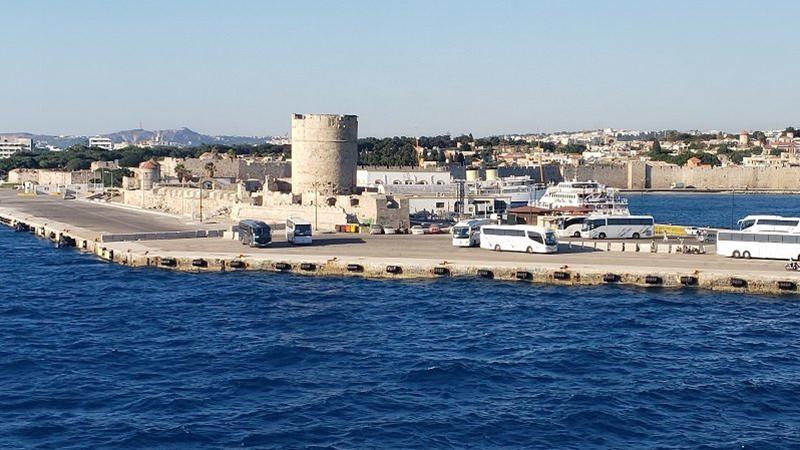
Our previous stories about this trip looked at the Celestyal approach to cruising and its fleet, as well as the ship's onboard dining and entertainment/ So, here are gleanings from our "time traveler" shore excursion with Celestyal on Rhodes, the "Island of Roses.”
The Port of Rhodes is a gateway to history with its massive fortifications, bastions and gates visible on the sea approach to the city. After their ship has docked, even Celestyal's guests who choose to remain aboard can simply look out to get a feel for the destination's historical bent.
Heading to Ancient Lindos
Travel Agent toured Rhodes as part of a small private group but the tour essentially mimicked a Celestyal shore excursion offered to all guests, "Acropolis of Lindos & the Citadel of Knights” (RHO-01). On the "Idyllic Aegean" itinerary, this is one of two complimentary tours offered to guests.
The tour began with a 40-mile scenic motorcoach ride along the island's eastern coastline. Gazing out the coach windows, we viewed modern beach resorts, citrus and olive groves, vineyards and seaside coves with azure blue-green waters. We also passed the remains of an old World War II runway.
Our destination was Lindos, a seaside town founded in the 10th century B.C. by the Dorians, a Greek ethnic group. Back in the day, Lindos (as with several other Rhodes port cities) was a powerful city-state, thanks to its maritime trade and eastern Mediterranean positioning between the Aegean and the Middle East. By the seventh century B.C., Rhodes even had its own "colonies" in the region. The island of Rhodes sent nine ships to fight in the Trojan War, and historians believe that probably all sailed from Lindos.
As cruisers, we were also fascinated to learn that the Lindians were the first to create a naval code of justice, the Rhodian Naval Code, which later became the foundation for the Roman Naval Code. Even today, some Lindian principles remain at the core of modern maritime law.
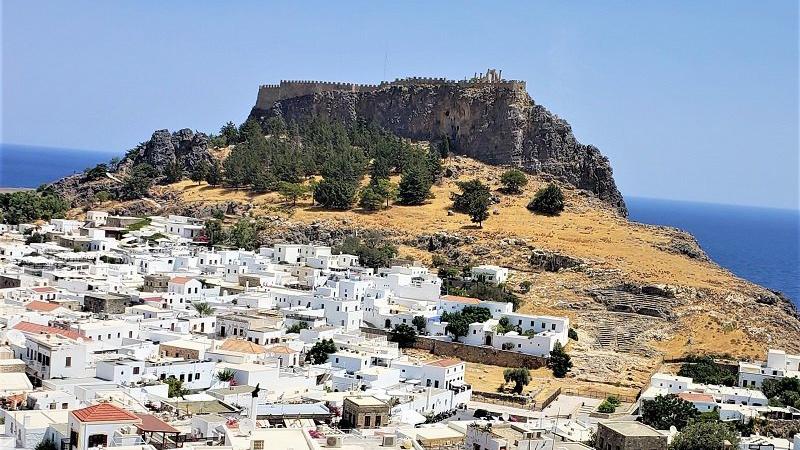
Challenging Climb
Dating from at least the 10th century B.C., Lindos’ Dorian-era acropolis was later “updated” by the ancient Greeks and Romans. Also, the knights left their mark here too by building walls around the acropolis and a palace atop it.
About two-thirds of our hearty band of Celestyal travelers opted to climb the 545 feet up to the acropolis. Those wishing to make this acropolis climb should be prepared for a strenuous uphill climb with surfaces that are rocky, uneven and without handrails. One fellow traveler spotted a teenager who’d fallen. Another person in our group went halfway up before turning around. That said, many travelers in our group were victorious in completing the climb.
Rewards are a sense of accomplishment and incredible views of ancient and medieval monuments, the white-washed town of Lindos below and two azure-blue bays, one Ayios Pavlos, the spot where the Apostle Paul arrived.
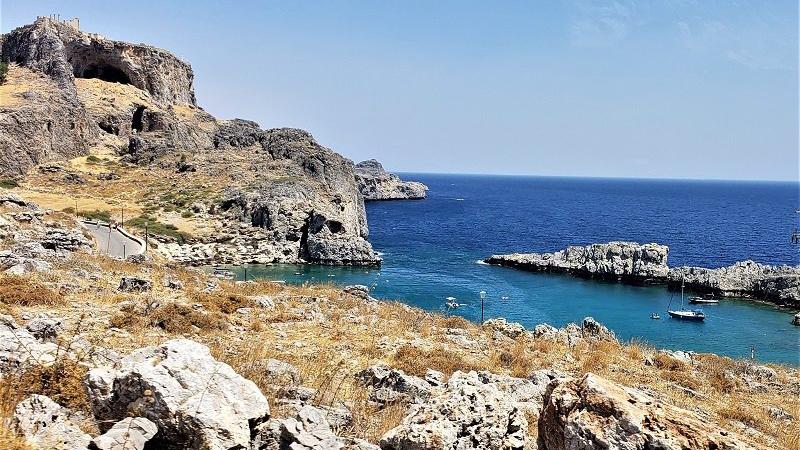
The steepest part of the climb is on stairs built by the Order of the Knights of St. John of Jerusalem, leading to their castle, which was renovated in the 15th century. If you climb, look atop the entry gate for the Grand Master Pierre d’Aubosson’s coat-of-arms.
Within the acropolis, our group also spotted historic architecture such as remains of a Roman temple, a Hellenistic Stoa with 42 Doric columns and ruins of a Byzantine church. A wide staircase leads to the Propylaea and beyond that to the ancient Greek temple of Lindian Athena.
In the early 20th century, the Archaeological School of Denmark carried out Lindos acropolis excavations—discovering stone tools that date to the Neolithic Period (third millennium B.C.). Other treasures uncovered were two marble plaques, inscribed by Timochidas, a priest of the Greek goddess Athena, in 99 BC.
What’s special is that one of those plaques lists several VIPs who supposedly visited the temple and brought gifts for the goddess. So, today's "climbers" can pride themselves in ranking with such plaque luminaries as Helen of Troy and Alexander the Great.
If you opt for the climb, be sure to wear comfortable, supportive shoes, not flip flops or sandals. Also bring sunscreen, a hat and a bottle of water as the sun and heat can be intense, particularly in summer.
White-Washed Lindos Town
Motorcoaches arriving with tours from the Port of Rhodes will drop their travelers at a parking area along the main road above town. Then, visitors will head down to the town via walking or taking a taxi or shuttle bus (available during certain hours). Cars are not permitted in town.
Once in town, visitors can head for "the climb" or explore the town. On our Celestyal trip, we were among several travelers who opted not to climb but to instead stay in Lindos' town center. We popped into a small, quiet Greek taverna to enjoy a coffee, juice and a home-make pastry on the eatery’s rooftop. Then we headed out to see such highlights as 16th- to 18th-century “Captains’ Houses; Lindos' ancient theater, which still retains some original seating and its orchestra area; and the 14th century Church of Our Lady (Theotokou), not far from the village square.
The church's historic bell tower is the perfect directional finder for those wanting to pop into the church for a look. Just be aware that no photos are permitted inside. This church has gorgeous artwork and is constructed in the shape of a cross. Tip: Check out the fine examples of 17th-century wood carving including a bishop’s throne. Personally, we loved the church's "chochlaki" Hellenistic flooring, consisting of black-and-white pebbles in a zip-zag pattern.
Shoppers will find plenty of diversions along Lindos’ narrow streets. Many travelers were browsing and buying at shops selling fashions, pottery, souvenirs, crafts and gifts.
Medieval, Old City Rhodes
After time in Lindos, we reboarded our motorcoach for the ride back to the medieval city of Rhodes for an Old City walking tour. After a short walk from the motorcoach, we entered through the walls via the Gate of St. Anthony.
Around every corner in the Old City is a treasure trove of thick walls, arches, fountains and historic buildings. It's easy to feel that one has strolled onto a Hollywood movie set. But alas, no, this was real.
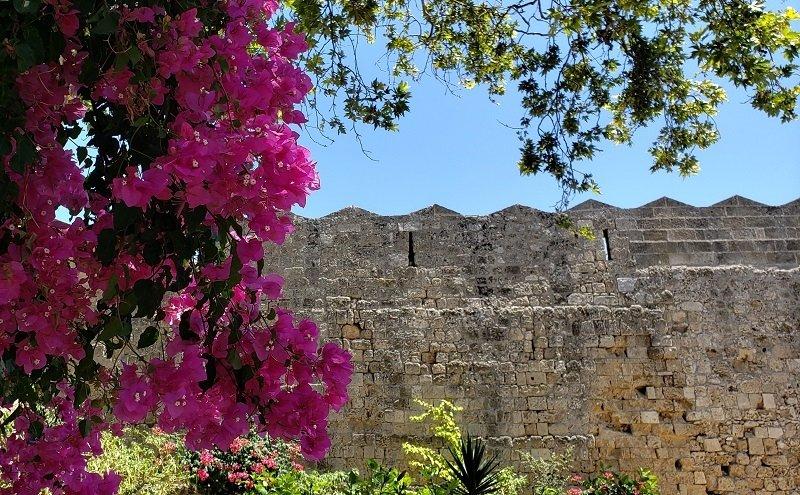
Between 1309 and 1522, the island of Rhodes was a sovereign state ruled by the Order of the Knights of St. John of Jerusalem (or later, they were called the Knights of Rhodes) . At that time, Rhodes rivaled Venice as a commercial port and even minted its own currency.
Founded during the First Crusade as a monastic order with a medical mission, the Order’s monks (also called “Hospitallers”) ran a Jerusalem hospital for Christian pilgrims. As the threat of Muslim invasion strengthened, the Order became increasingly militarized and eventually served as armed escorts for Christian pilgrimages in the Holy Land. Eventually, the knights became a multinational elite military force answering solely to the Pope.
In 1291, as Jerusalem fell to the Arabs, the Order moved first to Cyprus and then to a new base at Rhodes. Today, the knights' legacy continues. The Old City remains Europe’s largest, active medieval town, where an estimated 6,000 people live and work, many in historic structures once occupied by the knights.
The Old City is essentially comprised of two areas. The northern part (Collachium) and the southern part (Chora or Bourgo) were once divided by an interior wall. Today, Lachitos Street runs through the gate that divides those two sections.
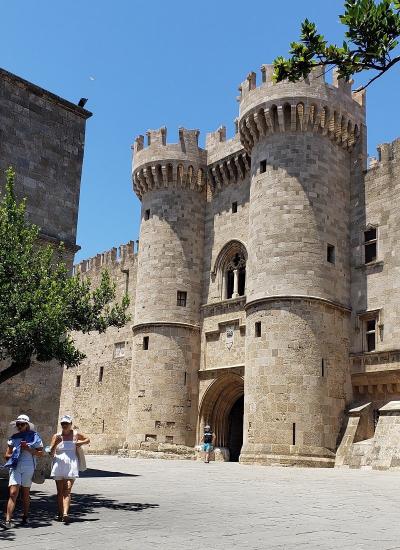
Rhodes. (Photo by Susan J. Young)
In the Collachium, travelers will discover the magnificent Palace of the Grand Master of the Knights of Rhodes (or acropolis of the knights), also called the Kastello. It served as the knights' administrative center, and in 1522 survived a siege with little damage.
That said, it was destroyed by a church explosion in 1865, but painstakingly rebuilt and restored by the Italians in 1940.
Other structures in the Old City to peruse include several churches and the houses of the knights, many still sporting their coat-of-arms seals. The Byzatine-era Church of Our Lady of the Castle is a popular stop for many travelers; it's at the beginning of Knights Street, which leads uphill to the Palace.
Symi Square, just inside the outer wall's Eleftherias Gate, was once called Arsenal Square as it’s believed here is where the knights’ naval station was located.
Argyrokastro Square is home to a gorgeous early Christian baptistry, while Museum Square houses the Historical and Archeological Institute (formerly the Knights’ Hospital), which displays many of Rhodes’ art masterpieces and mosaics.
One highlight along the route is the Inn of the Language (Langue) of France, located along the Street of the Knights. It's one of the inns of the various nationalities found in the old city.
Also in the Old City, visitors can shop ‘till they drop on Sokratous Street, a long bazaar with a seemingly unending array of souvenirs, crafts and clothing.
The city has 200 or so streets or narrow alleys, some with no names. So, if lost, just ask for Sokratous Street. Someone will likely point you in the right direction.
Among many other sites of interest are the Holy Trinity, or "Ayia Tricia," the remains of a notable Byzantine church; the Old Town's synagogue and the Square of Jewish Martyrs, home to lovely fountain decorated with starfish, octopi and blue tiles; a clocktower; and the Suleymaniye Mosque.
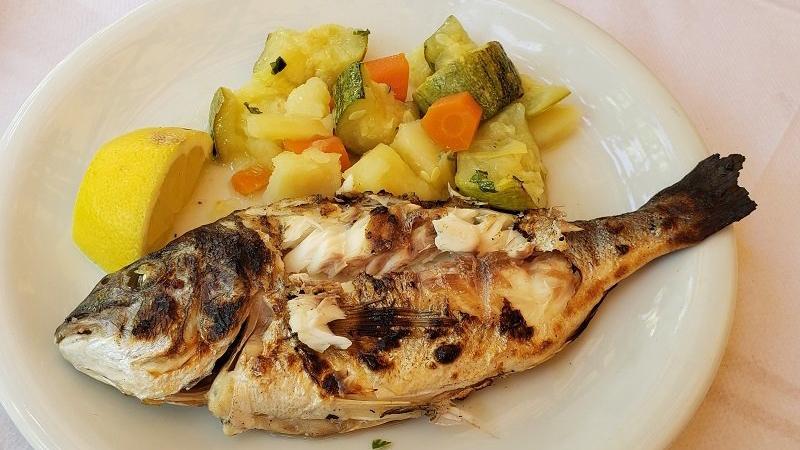
For lunch, our group dined at Restaurant Vasilis at 16 str. Sofocleous, Old Town in Rhodes. One plus is its attractive, outdoor courtyard. The lunch-time menu focused on Greek traditional specialties, seafood, fresh fish and fresh fish, as well as Greek salads.
Walking back to the ship on our own, we transited one of the Old City's medieval gates—marveling at the staying power of these Gothic defensive elements. Did you know that two-and-one-half miles of fortification walls still remain? It's true. All walls were once surrounded by a moat.
During our port day in Rhodes, Celestyal also offered two others tours to its guests—a “Medieval Tour Philerimos Church & Palace of Knights” (RHO-02) tour, also at 74 euros (approximately $87) per person for adults and 55 euros (approximately $65) for children aged three to 12, and a “Walking Tour Medieval Rhodes” (RHO-11) option at 47 euros (approximately $55) for adults, 30 euros (approximately $35) for children.
More Rhodes Exploration
"I always love touring through the old town of Rhodes as it provides the perfect blend of history," says Drew Daly, senior vice president and general manager, Dream Vacations, CruiseOne and Cruises Inc. "Exploring the medieval town to envision what life was once like is just awesome." He visited Rhodes in July during a Celebrity Cruises’ Celebrity Apex voyage in Greece.
He told Travel Agent that he loved visiting the knights' palace, museum and learning more about the history of Rhodes and its importance to maritime trade for the area.
In addition, "it's always interesting to try and envision where exactly the Colossus of Rhodes once stood," says Daly.
Completed around 292 B.C., that incredibly tall statue—by some accounts 108 feet high—was considered one of the "Seven Wonders of the Ancient World." Taking 12 years to build, it represented the Greek sun-god Helios. But the Colossus collapsed in a 266 B.C. earthquake and remained in a heap for centuries, until 653 A.D. when it was sold by pillaging Arab to a Jewish trader. Legend says it took 900 or so camels to transport the pieces away.
While the exact location of where the Colossus once stood (or whatever happened to its pieces) remains a mystery, most historians believe it actually was located "on land" near the Castello. So, it likely didn't straddle the harbor as in the legend that dates from the Middle Ages.
Another option for cruisers in Rhodes, suggested by Daly, is to head for one of the island's beaches to rest, relax or enjoy water play. On our cruise, Celestyal offered beach transfers in numerous Greek ports of call.
In addition to our July Celestyal shore excursion to Lindos ad Rhodes, we also went ashore a second time at Rhodes in August—this time on a Greek islands cruise of Silversea Cruises’ Silver Moon. We opted for the four-and-a-half-hour included “Panoramic Rhodes” shore excursion through both old and new areas of Rhodes city, with views of the National Theater, the Aquarium, a mosque and other sites.
Several miles beyond, the coach motored inland and we could see a few ancient columns standing on Rhodes' acropolis. Then our coach continued via a winding road to the 1,000-foot plateau of Mt. Filerimos, which is also home to another archeological site.
Here is where the ancient town of Ialyssos' acropolis was located. Today, there are a few scattered ruins visible.
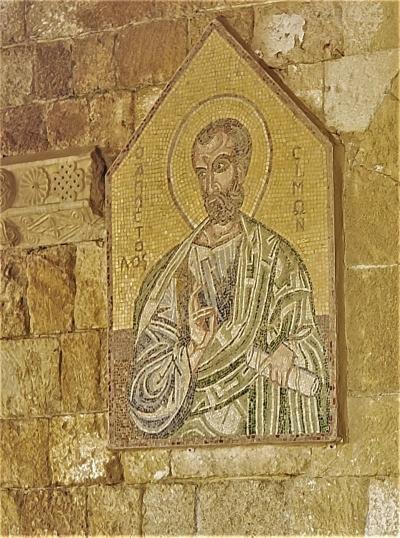
wall. (Photo by Susan J. Young)
Mostly, this stop was a chance to walk around the exterior of the restored Church of Our Lady, a monastery and the barrel-vaulted Church of St. George, as well as enjoy scenic countryside and Rhodes views.
Next, this Silversea tour continued to Lindos, where the motorcoach made several photo stops, including one at the Bay of St. Paul, which we hadn't seen on the other tour.
Then it was on to Kalathos Village for a Savvas family pottery and ceramics demonstration, before passing Monte Smith for views overlooking Rhodes, the Old City's Kastello and the coast of Turkey, before the coach returned to the Port of Rhodes.
Other "included" tours offered by Silversea for Silver Moon's guests this year are: “The Acropolis of Lindos,” “Medieval Rhodes,” “Lindos and Rhodes Discovery with Lunch” and a “Rhodian Pottery Workshop.”
For us history buffs, Rhodes was an incredibly fascinating place—one we can't wait to return to in the future. For anyone who loves to envision the past while exploring tales of history ashore, this island is "a must"—a way to feel as though one is "a time traveler" moving through a land of Dorian, Greek, Roman and Byzantine antiquities and remembrances.
For more information, check out www.visitrhodes.com.
Related Stories
“Ahoy” Greece: Eastern Med Cruises
Brown Hotels Makes Debut in Greece
On Location: Greek Island Hopping on Celestyal Cruises
Europe's WWII Sites Draw Veterans' Families and History Buffs